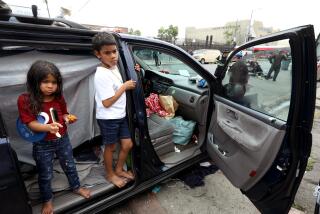School of Hard Knocks : Children Imagine Being Homeless in Classroom Video
- Share via
NORWALK — The fifth-graders at Lakeland Elementary School in Norwalk took a walk down Maple Drive this year, a route one student described as a street of hunger, homelessness and pain.
Homelessness, centered on the fictional Maple Drive, became the center of the class curriculum in March, when teacher Mary Kreutz gave the students a simple assignment: Imagine that you are homeless. Write about your life.
“Veronica Garcia’s entry made me cry,” Kreutz said. “This is what started it all.”
Veronica, 11, wrote: “I wasn’t always homeless; I had a husband and three kids and a nice house. Then my husband died. I couldn’t handle it, and I started drinking. Then I lost my job. But I still remember the feel of a hot shower, me and my kids snuggled up in a warm bed, and my husband in the kitchen cooking a hot meal for his family.”
Before long, members of the Cam Corps Club, who are learning to use video cameras, began taping classmates as they read their stories about living on the streets.
The children built a homeless camp of cardboard boxes, newspapers and an old shopping cart. Then Dustin Belot, 11, added commentary, and a videotape on homelessness began to take shape.
In the video, “Maple Drive U.S.A.,” Dustin asks his classmates, playing homeless people, to tell their life stories. The tape also shows a group of neighbors giving food to homeless people encamped in the cardboard village while protesters, who are afraid to have the homeless in their neighborhood, try to get them to leave.
“We’re trying to avoid stereotypes,” Kreutz said. “We want to show all sides of the issue.”
Max Flores, 10, who plays a homeless person in the film, said he learned a lot. “Teacher said people think kids don’t care about the homeless or know about them, but we do,” he said. “After the riots, a lot of people lost their jobs, so now there’s going to be a lot more homeless people.”
The children didn’t use scripts for the video, said Nadine Cornejo, 11. “We just speak from the heart. Mrs. Kreutz says it’s better that way.”
Two weeks into the video project, the class invited community members to talk to them about homelessness. While taping for their documentary, they asked questions of the panel--two members of the state Assembly, three school officials, a pair of social workers, two homeless advocates, a Norwalk policeman, a PTA member and a mental-health expert.
A school principal told them that 20 to 30 students at a nearby school were homeless. An assemblyman said that if the state spends more money on homeless people, it would have to cut the school budget. A social worker told them that if they encounter homeless children, please be kind.
Kreutz, 42, also had told them about her own economic struggle. In 1976, after her marriage broke up, she found herself nearly destitute, with no job prospects, few skills and four children ranging in age from 2 months to 5 years. She struggled to survive on welfare, attended college full time, and by 1983 she had a degree in education from Cal State Long Beach.
“I tell my students about my life so they’ll know how important education is,” Kreutz said. “Everybody struggles to get where they’re going, including me.”
A warm, enthusiastic teacher, Kreutz praises her students and often hugs them. She frequently calls them “a great bunch of kids.”
Kreutz said the students led the way in their study of homelessness. “It’s something the kids felt was important. . . . There was a feeling that maybe we can’t change the world, but we can do a little bit as fifth-graders.”
The class sponsored a “jog-a-thon” in early June to raise money for the nearby Rio Hondo homeless shelter, where more than 50 children, including six newborns, live with one or both of their parents.
Instead of having an end-of-the-year field trip, they visited the shelter taking toys, stuffed animals, clothing, food, homemade cookies and a coffee can filled with nearly $400 they had raised.
As shelter staff member Denise Malavisi led the class through the large, airy Spanish-style building, one child asked, “Where are all the kids?”
“They’re in school, just like you,” she said.
After seeing the shelter’s kitchen, child-care center and literacy lab, the fifth-graders rested on the shaded playground behind the shelter and talked with Malavisi. She thanked them for visiting and for caring about the shelter residents. Then she asked what they had learned about the homeless in their months of study.
“They’re the same as us,” Martha Gomez, 11, answered. “They’re no different. They just don’t have a home.”
More to Read
Sign up for Essential California
The most important California stories and recommendations in your inbox every morning.
You may occasionally receive promotional content from the Los Angeles Times.













